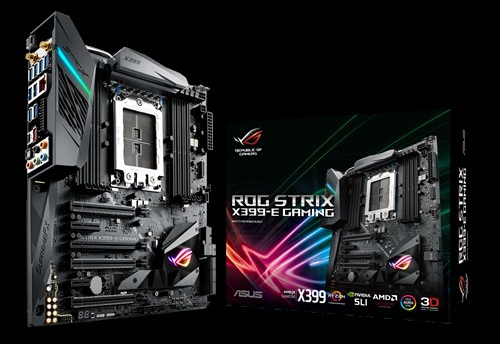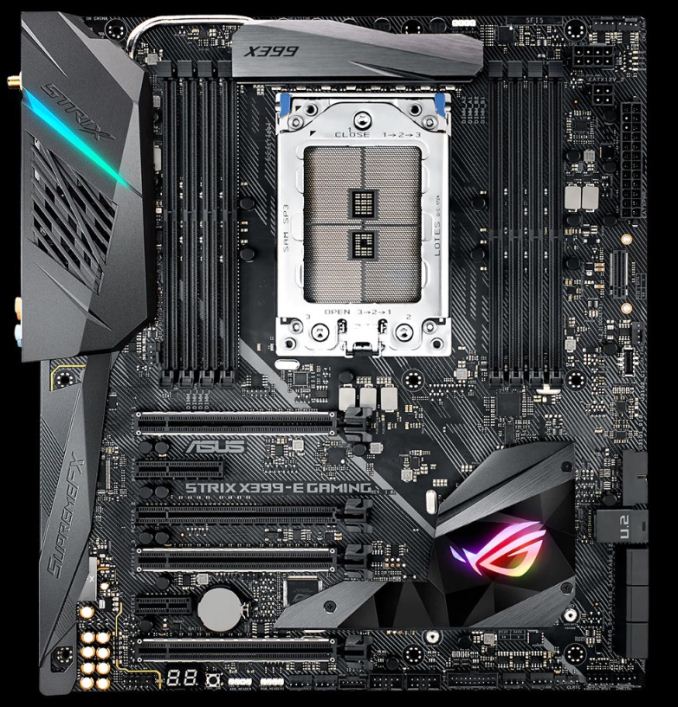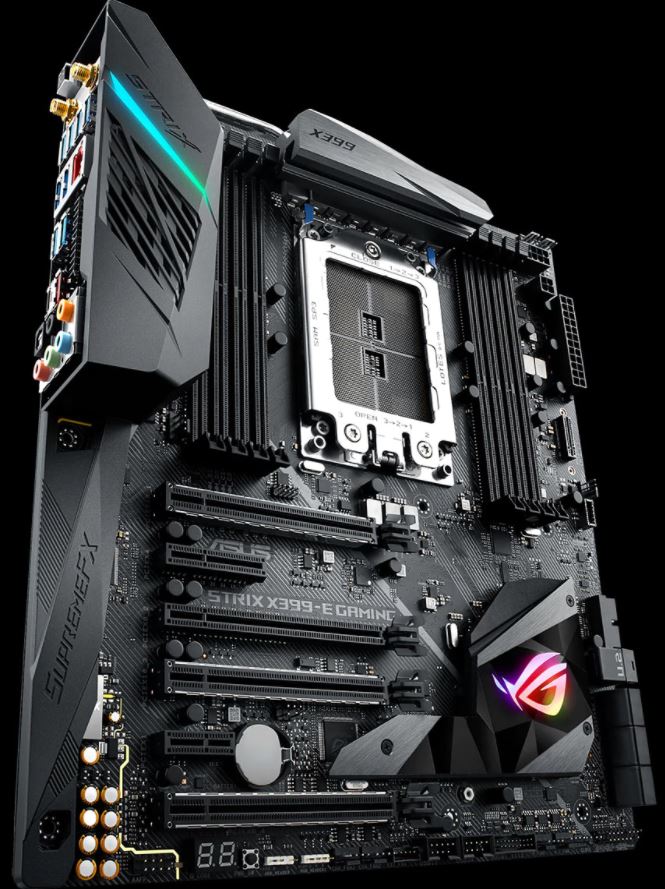An AMD Threadripper X399 Motherboard Overview: A Quick Look at Seven Products
by Ian Cutress & Joe Shields on September 15, 2017 9:00 AM ESTASUS ROG Strix X399-E Gaming
With the advent of eSports and the ability to stream and even broadcast your own gaming sessions, PC gaming has gained a significant amount of momentum the past few years. So much so, many (if not all) of the motherboard partners have latched on to the nomenclature and started entire lines for 'gaming' motherboards. ASUS is no different with gaming based motherboards, out for generations now under the ROG name, and continues to do so on the X399 Threadripper platform in the ROG Strix X399-E Gaming. Strix as a brand has migrated from a 'zero-noise' implementation to the more budget oriented gaming products from ASUS.
The ROG Strix falls between the Zenith Extreme and the Prime with a mix of features. For example, the Strix includes WiFi and Bluetooth connectivity, like the flagship Zenith Extreme, or that the Prime and Strix each have a single Intel I211-AT Gigabit LAN while the Zenith has three network ports including a 10 GbE. The Strix X399-E Gaming has eight DRAM slots, supports multiple GPUs (SLI and Crossfire), uses the latest audio codec (Supreme FX S1220A for the Strix), a capable VRM, multiple storage options, and RGB lighting among other features.
Looking over the board in detail, we'll start at the top. First, the VRM configuration is an eight-phase design. It is cooled by dual heat sinks running along the top of the socket with the second sitting between the memory slots and rear I/O. Extra cooling on the VRMs is provided by an included 40mm fan sitting under the I/O shroud (similar to the Zenith). Both EPS connectors, an 8-pin and 4-pin, as well as the 24-pin ATX connector, are in the top right-hand corner of the board. Below that is the second M.2 slot. An M.2 drive in this slot, like in the Prime, sticks out from the board instead of laying flat. ASUS does include an M.2 bracket for the slot to assist with supporting the standing device.
Continuing to move down the motherboard, below the vertical M.2 slot is the USB3.1 (10 Gbps) header fed from the chipset. For cases that have front panel USB 3.1 ports, this is typically the header used for that connectivity. Below that is the single U.2 port and six SATA ports.
The chipset heatsink on the ROG Strix houses RGB LEDs that can be adjusted with the AURA Sync software. The only other LEDs on the board are located on the I/O cover. The chipset heatsink extends on the bottom between the last two full-length PCIe slots and covers the first M.2 slot providing additional cooling for those devices.
The Strix offers four full-length PCIe slots, three use a reinforcing guard and is where users will slot their graphics cards for optimal performance. The PCIe arrangement allows for up to a triple slot video card between slot 1 and slot 3, and a dual slot card will fit between between slot 3 and slot 4. Slot breakdowns are x16 for single, x16/x16 for dual GPUs, and x16/x16/x8 when using three GPUs. Additionally there is one PCIe x1 slot, a PCIe x4 slot, and full-length PCIe slot (x4). These slots distinguish themselves by not having the reinforcement.
Across the bottom of the board are more onboard headers. These include external addressable RGB LED headers, fan headers, and USB3.0 headers. It also has a debug display as well as a small power button for testing outside of the case. On the left side of the board is where the audio parts are housed. Mostly concealed under the shroud is an EMI protected ALC1220A codec using upgraded filter caps, and PCB separation of the audio components from the rest of the board.
The rear I/O panel is fairly busy with a BIOS reset button, wireless connectivity, eight USB 3.0 ports, and the Gigabit Ethernet port taking up most of the real estate. USB 3.1 Type-A and Type-C ports from the ASMedia controller are also present, with the audio jacks, including SPDIF output, rounding out the rear panel.
| ASUS ROG Strix X399-E Gaming | |
| Warranty Period | 3 Years |
| Product Page | Link |
| Price | N/A |
| Size | ATX |
| CPU Interface | TR4 |
| Chipset | AMD X399 |
| Memory Slots (DDR4) | Eight DDR4 Supporting 128GB Quad Channel Up to 4133 MHz (OC) |
| Network Connectivity | 1 x Intel I211-AT GbE |
| Wireless Network | Wi-Fi 802.11 a/b/g/n/ac |
| Onboard Audio | SupremeFX S1220A |
| PCIe Slots for Graphics (from CPU) | 4 x PCIe 3.0 x16 Supports SLI/CF |
| PCIe Slots for Other (from Chipset) | 1 x PCIe 2.0 x4 (max) 1 x PCIe 2.0 x1 |
| Onboard SATA | 6x Supporting RAID 0/1/10 |
| Onboard SATA Express | None |
| Onboard M.2 | 2 x PCIe 3.0 x4 - PCIe or SATA |
| Onboard U.2 | 1 x PCIe 3.0 x4 |
| USB 3.1 | 1 x Header 1 x Rear Panel Type-A 1 x Rear Panel Type-C |
| USB 3.0 | 8 x Rear-Panel 2 x Header |
| USB 2.0 | 2 x Header |
| Power Connectors | 1 x 24-pin EATX 1 x 8-pin ATX 12V 1 x 4-pin ATX 12V |
| Fan Headers | 1 x M.2 1 x CPU 1 x CPU OPT 3 x Chassis 1 x AIO_PUMP 1 X w_PUMP+ 1 x 5-pin EXT_FAN |
| IO Panel | 1 x Intel NIC 1 x USB 3.1 Type-A 1 x USB 3.1 Type-C 8 x USB 3.0 1 x Optical S/PDIF out 5 x Audio jacks 1 x USB BIOS Flashback Button 1 x 2x2 Wi-Fi 802.11 a/b/g/n/ac |
ASUS mentioned pricing for the Strix X399-E Gaming to be at a more affordable price than their flaghsip ROG Zenith Extreme. It is currently available through smaller distributors, perhaps as a pre-order, but not found on Newegg or Amazon at the time of writing (9/11).













99 Comments
View All Comments
Vorl - Friday, September 15, 2017 - link
Heads up, the X399 Taichi product link is linked to the pro gaming motherboard link.milkod2001 - Friday, September 15, 2017 - link
Grossly overpriced boards. Cay they drop this LED nonsense & ugly plastics and make proper boards at reasonable $250?DanNeely - Friday, September 15, 2017 - link
The RGB cancer isn't why these boards are so expensive. It's stupid, but only adds a few dollars to the cost; not a few hundred.It's all the extra PCB layers they need to support the 4000 connections to the CPU socket and route all the extra PCIe lanes. Limiting the number of PCIe lanes in mainstream chips is as much about being able to use smaller sockets and fewer PCB layers to keep board costs down as it is a desire on AMD and Intel's part to upsell to X299/X399 systems. The fact that the mobo vendors are probably expecting to sell dozens of mainstream boards for every one of these halo products doesn't help either because it means that the R&D costs can't be spread anywhere near as widely.
For the two boards that have them, the $100 for a 10GB NIC doesn't help any.
tamalero - Sunday, September 17, 2017 - link
Still annoying and useless. They just wanted to appeal the extra gaming segment when this entire system is not for gaming.Now add the fact that almost every goddarn high end videocard AND memory now have shitty RGB lights as well.
Its a waste of power.
CheapSushi - Sunday, September 17, 2017 - link
Are you assuming enthusiasts are all just gamers? You can be an enthusiast that loves gaming AND content creation. If you want no-nonsense then maybe go EPYC instead (YES, it is a workstation platform too, not just server): http://b2b.gigabyte.com/Server-Motherboard/MZ31-AR...mapesdhs - Tuesday, September 19, 2017 - link
Amazing how many people just assume that a PC user is either a gamer or not a gamer. There's a lot of crossover with content creation these days, and also people who stream. Being able to play a game, record the gameplay, convert a previous session and upload it to YT/etc. will be a boon for those who make a living doing such things.CheapSushi - Sunday, September 17, 2017 - link
Finally a voice of reason for the naggers.ddarko - Friday, September 15, 2017 - link
Anyone interested in pairing the Asus Zenith Extreme with the Threadripper version of the Noctua NH-U14S should note that the cooler blocks the first PCI-E x16 slot on the board. Noctua says Asus didn't follow the AMD clearance guidance on this board; you can see in the pic that the top slot is very very close to the CPU bracket.glennst43 - Friday, September 15, 2017 - link
NH-U12S TR4-SP3 will fit though: http://noctua.at/en/nh-u12s-tr4-sp3/specification. I read a German article that showed that this cooler provides very similar cooling perf and noise as compared to the 14S. I have 2 other systems that use variations of the 14s, and I can not find any noticeable noise difference. Still an unfortunate design decision from Asus.DanNeely - Friday, September 15, 2017 - link
Other than the MSI board, I notice that none of them are putting USB2 ports on the back panel. Does that mean the interference problems that some USB2 devices encountered in 3.0 ports have been fixed; or that the mobo makers just feel anyone who needs them can use an IO bracket attached to an onboard header?